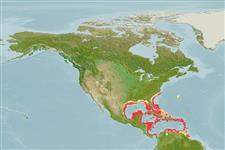Environment: milieu / climate zone / depth range / distribution range
นิเวศวิทยา
เกี่ยวกับทะเล,น้ำเค็ม เกี่ยวกับหินโสโครก; ไม่มีการอพยพย้ายถิ่น (Ref. 56524); ระดับความลึก 0 - 170 m (Ref. 9710). Subtropical; 36°N - 6°N, 98°W - 58°W (Ref. 5222)
Western Central Atlantic: North Carolina to southern Florida (USA), Bermuda, Gulf of Mexico, Bahamas, and the Caribbean; including the Antilles (Ref. 26938).
Length at first maturity / ขนาด / น้ำหนัก / Age
Maturity: Lm 16.0, range 14 - ? cm
Max length : 42.6 cm TL เพศผู้/กระเทย; (Ref. 40637); common length : 20.0 cm TL เพศผู้/กระเทย; (Ref. 3708); น้ำหนักสูงสุดที่มีการรายงาน: 1.1 kg (Ref. 40637); อายุสูงสุดที่ได้รายงาน: 13 ปี (Ref. 36271)
เงี่ยงครีบหลัง (รวม) : 9; ก้านครีบอ่อนที่หาง (รวม) : 13 - 15; เงี่ยงครีบก้น: 3; ก้านครีบอ่อนที่ก้น: 8. Distinguished by having the following characteristics: body depth 2.5-2.9 times in SL; head length 2.4-2.6 times in SL (Ref. 089707); opercle with 3 flat spines, middle one the largest and upper spine longer than the lowest; pelvic fins shorter than pectorals; bases of soft dorsal and anal fins covered with scales and thick skin; has 4 contrasting spots, white or black, along body below dorsal fin base (Ref. 26938); color in market: pale orange, grey or brown with reddish spots; black spots on the upper body below the dorsal fin (Ref. 089707).
Inhabits Thalassia beds and coral reefs. In the Gulf of Mexico, they are found on rocky reef ledge in depths greater than 27 m. Solitary (Ref. 26340) and secretive, they usually stay near hiding places during the day. Prefer to remain within a small area of the home range of about 2,120 square m especially during the day (Ref. 56524). Nocturnal predators, adults feed mainly on fishes, with preference on Chromis multilineata, while juveniles feed on shrimps. Due to its small size, this is not a particularly sought-after species. Easily approached and fed by divers (Ref. 9710). Protogynous (Ref. 26938). Between 1995 and 2000, at least 10 specimens have been traded as aquarium fish at Ceará, Brazil (Ref. 49392).
Most change sex between 20 and 23 cm (ages 4 and 5), with sexual transition occurring immediately after spawning in August and September (Ref. 3092).
Heemstra, P.C. and J.E. Randall, 1993. FAO Species Catalogue. Vol. 16. Groupers of the world (family Serranidae, subfamily Epinephelinae). An annotated and illustrated catalogue of the grouper, rockcod, hind, coral grouper and lyretail species known to date. Rome: FAO. FAO Fish. Synop. 125(16):382 p. (Ref. 5222)
IUCN Red List Status (Ref. 130435)
Threat to humans
Reports of ciguatera poisoning (Ref. 30303)
Human uses
การประมง: มีการค้าเพียงเล็กน้อย
เครื่องมือ
Special reports
Download XML
แหล่งที่มาจากอินเตอร์เน็ต
Estimates based on models
Preferred temperature (Ref.
123201): 22.7 - 28, mean 26.4 °C (based on 328 cells).
Phylogenetic diversity index (Ref.
82804): PD
50 = 0.5000 [Uniqueness, from 0.5 = low to 2.0 = high].
Bayesian length-weight: a=0.01148 (0.00674 - 0.01956), b=3.06 (2.92 - 3.20), in cm total length, based on LWR estimates for this species & Genus-body shape (Ref.
93245).
ระดับชั้นอาหาร (Ref.
69278): 4.3 ±0.6 se; based on diet studies.
ความสามารถในการกลับคืนสู่ปกติ (Ref.
120179): ขนาดกลาง, เวลาต่ำสุดที่จะทำให้ประชากรเพิ่มขึ้นเป็น 2 เท่าใช้เวลา 1.4 - 4.4 ปี (K=0.34-0.35; tm=3.5-5.5; tmax=9; Fec=260,000).
Fishing Vulnerability (Ref.
59153): Low to moderate vulnerability (33 of 100).
Nutrients (Ref.
124155): Calcium = 28.1 [12.8, 57.6] mg/100g; Iron = 0.548 [0.279, 1.129] mg/100g; Protein = 19.3 [17.4, 20.9] %; Omega3 = 0.285 [0.157, 0.507] g/100g; Selenium = 21.1 [9.8, 42.1] μg/100g; VitaminA = 86.8 [30.2, 314.7] μg/100g; Zinc = 0.479 [0.320, 0.816] mg/100g (wet weight);
